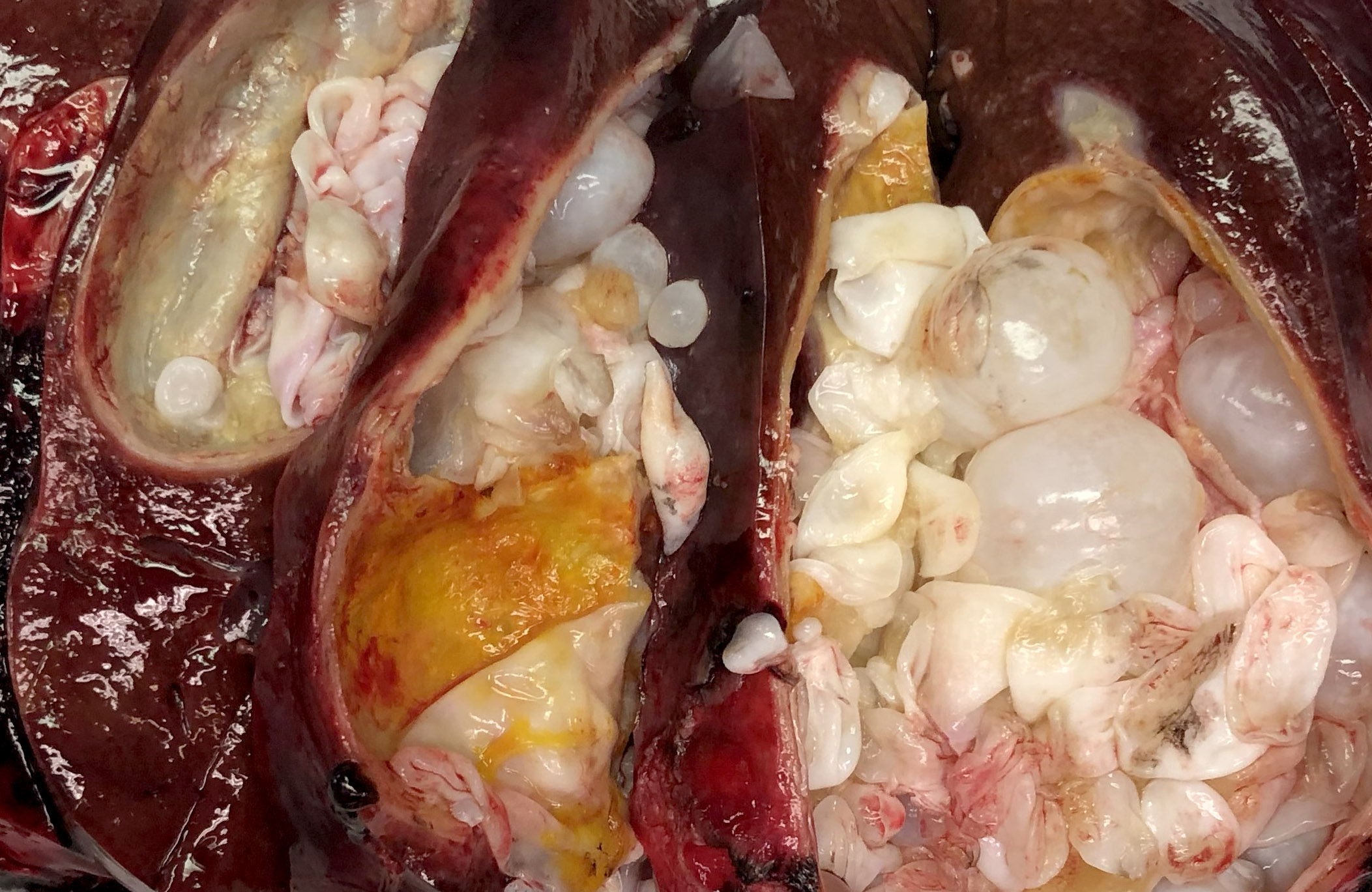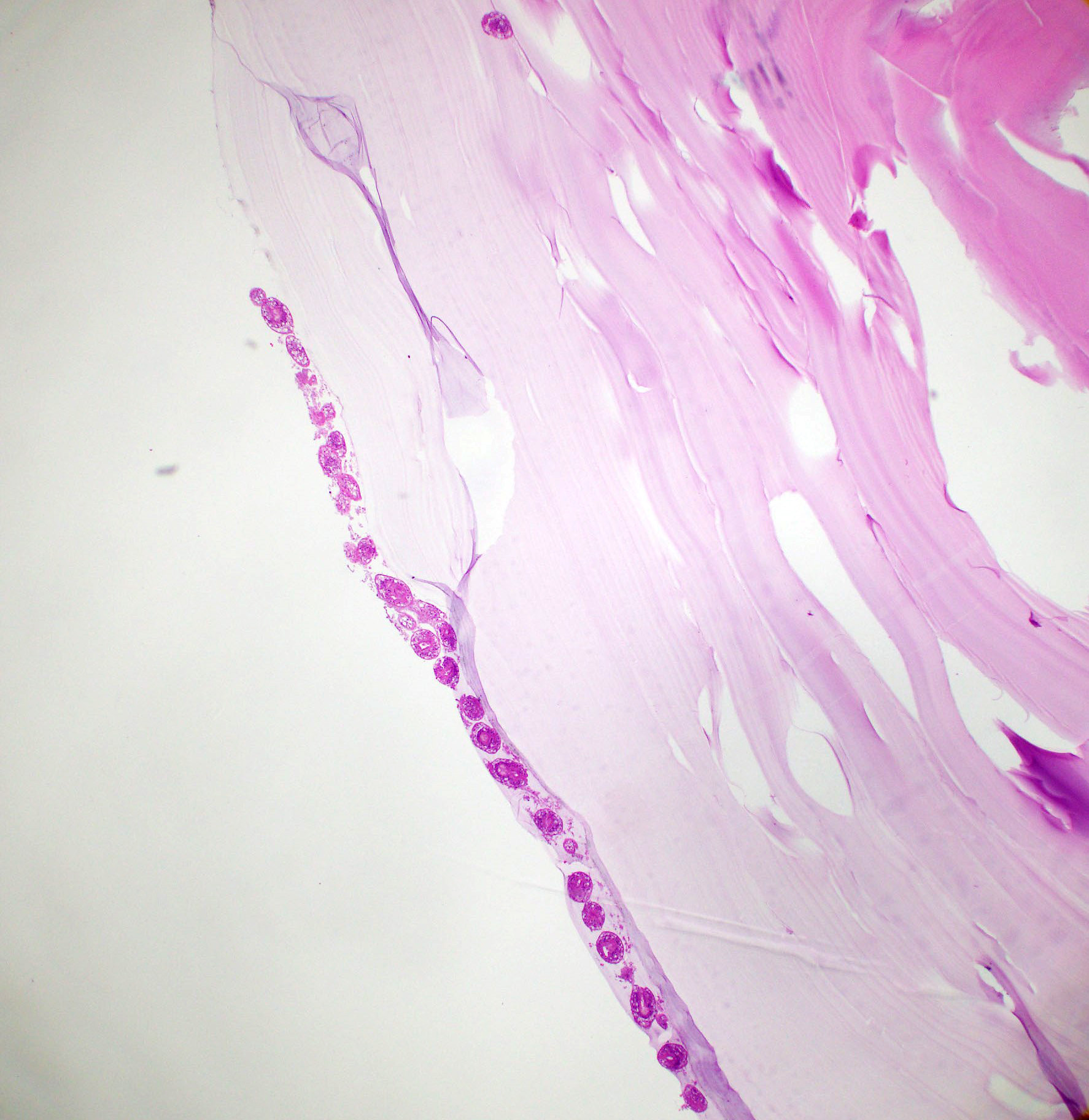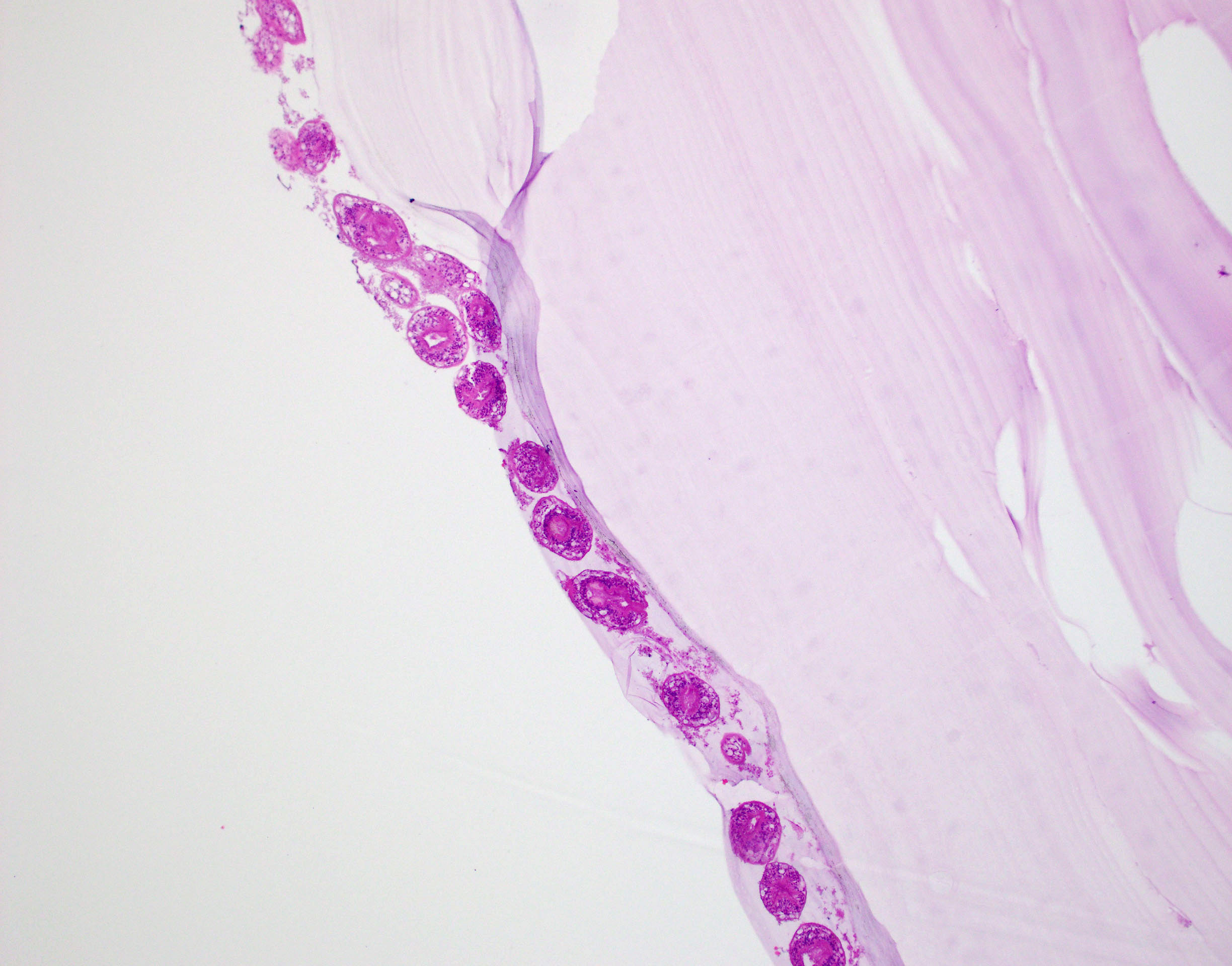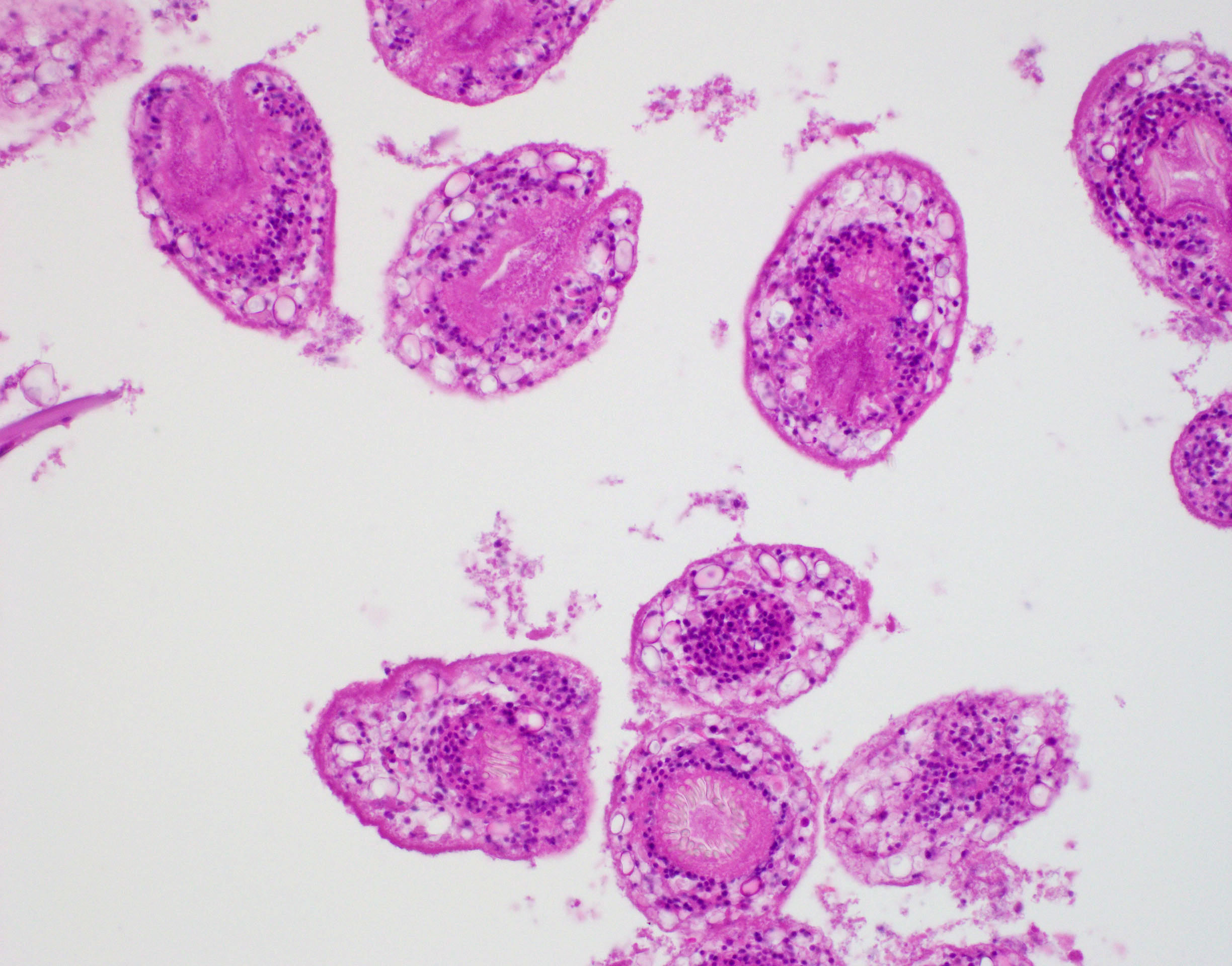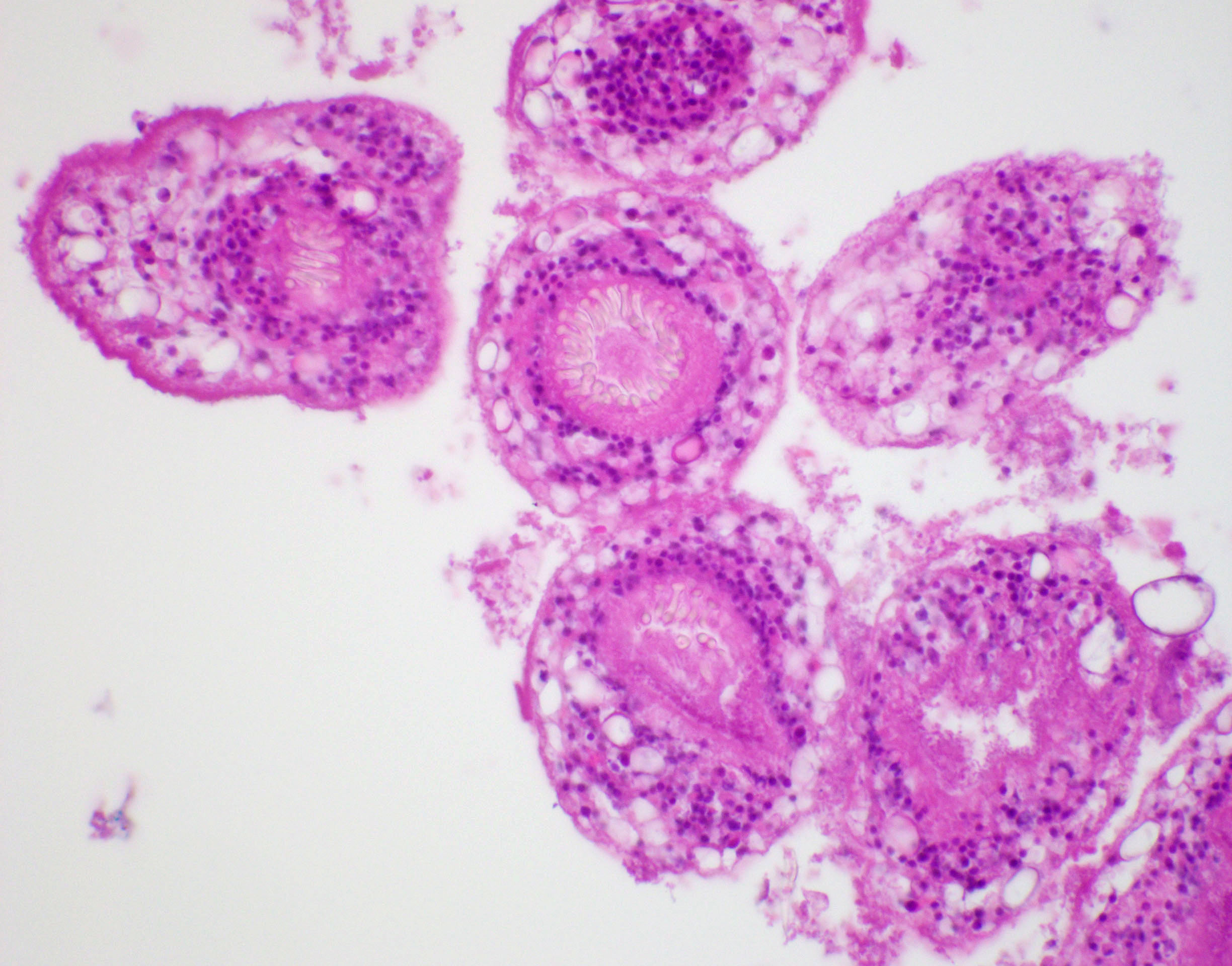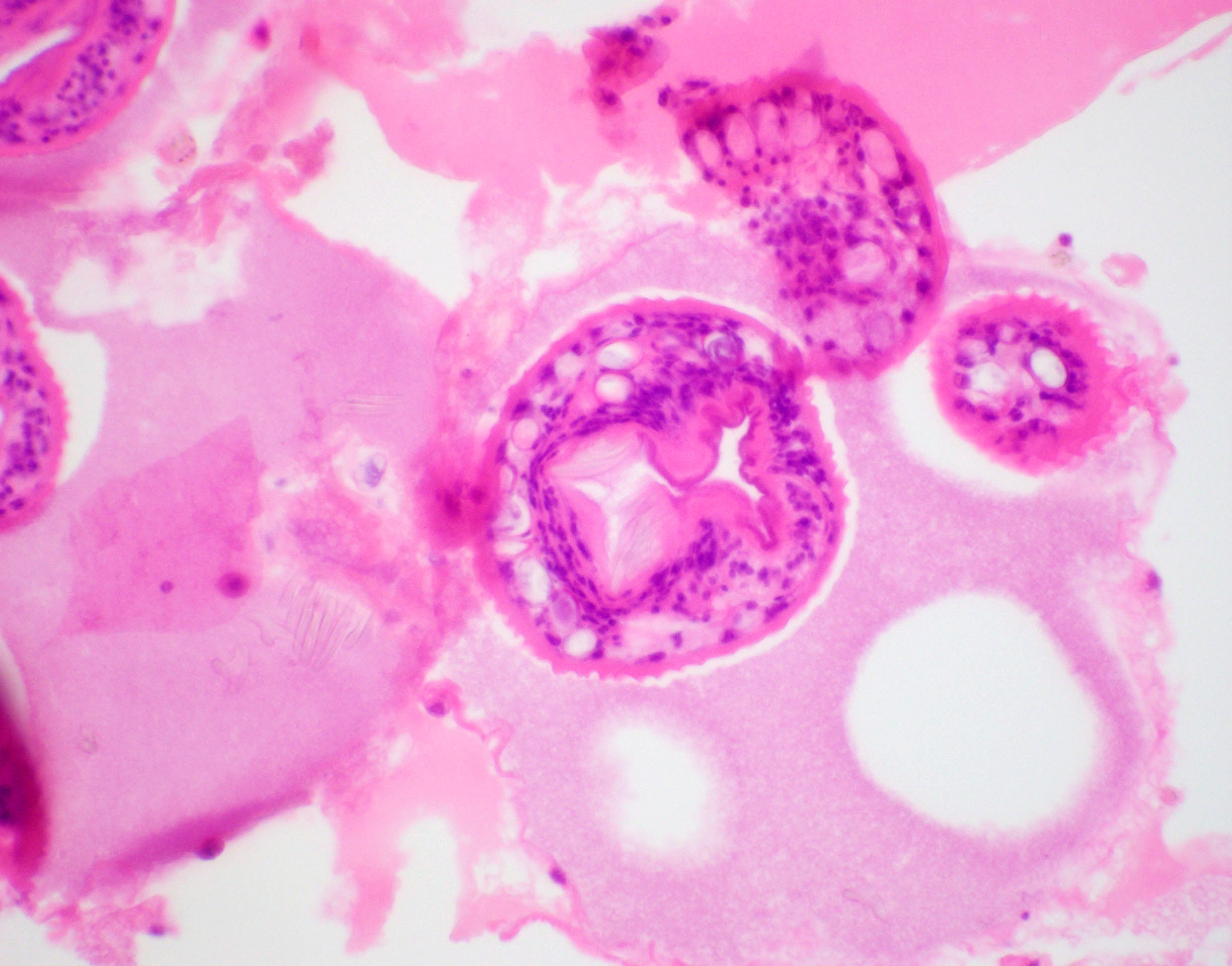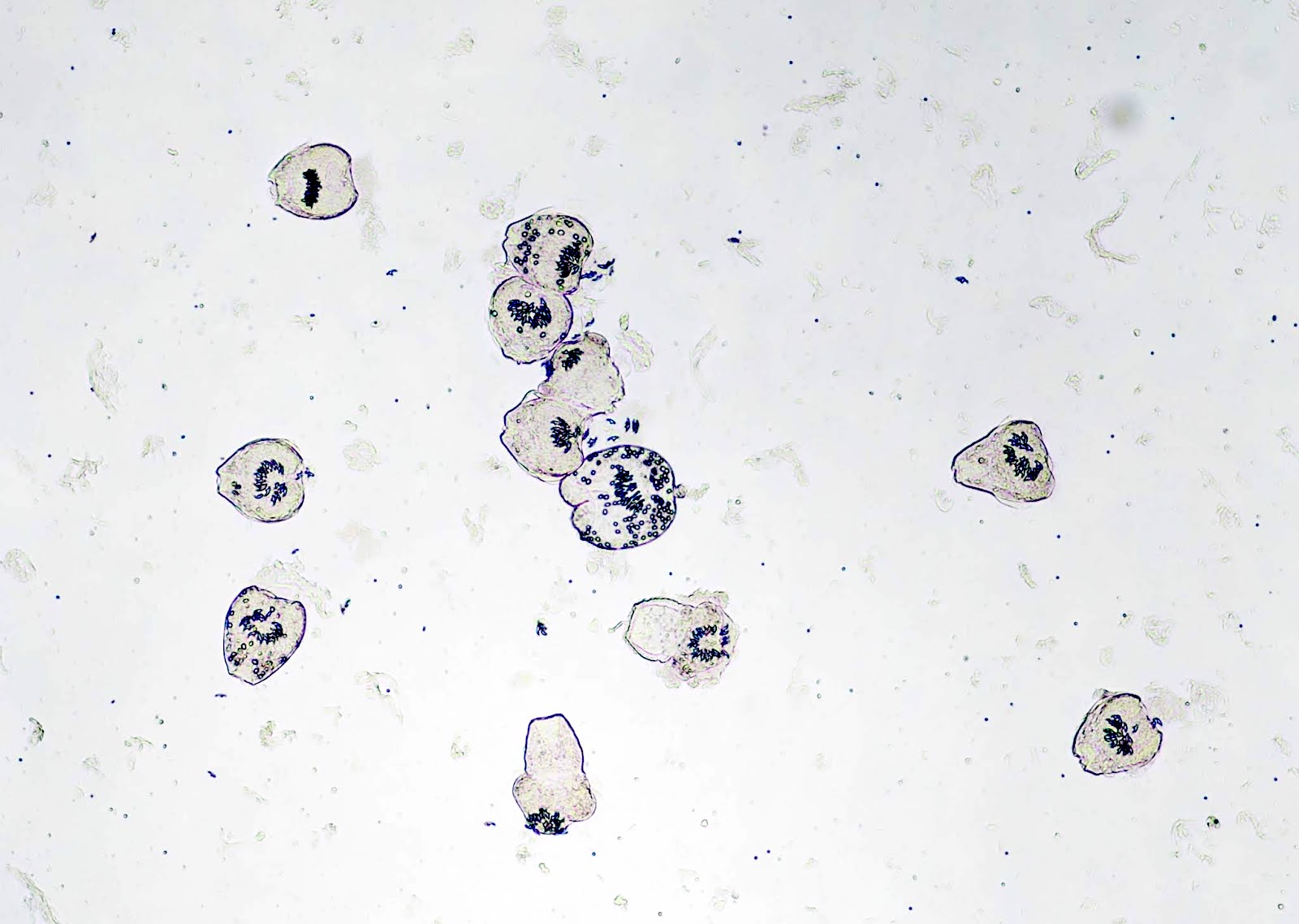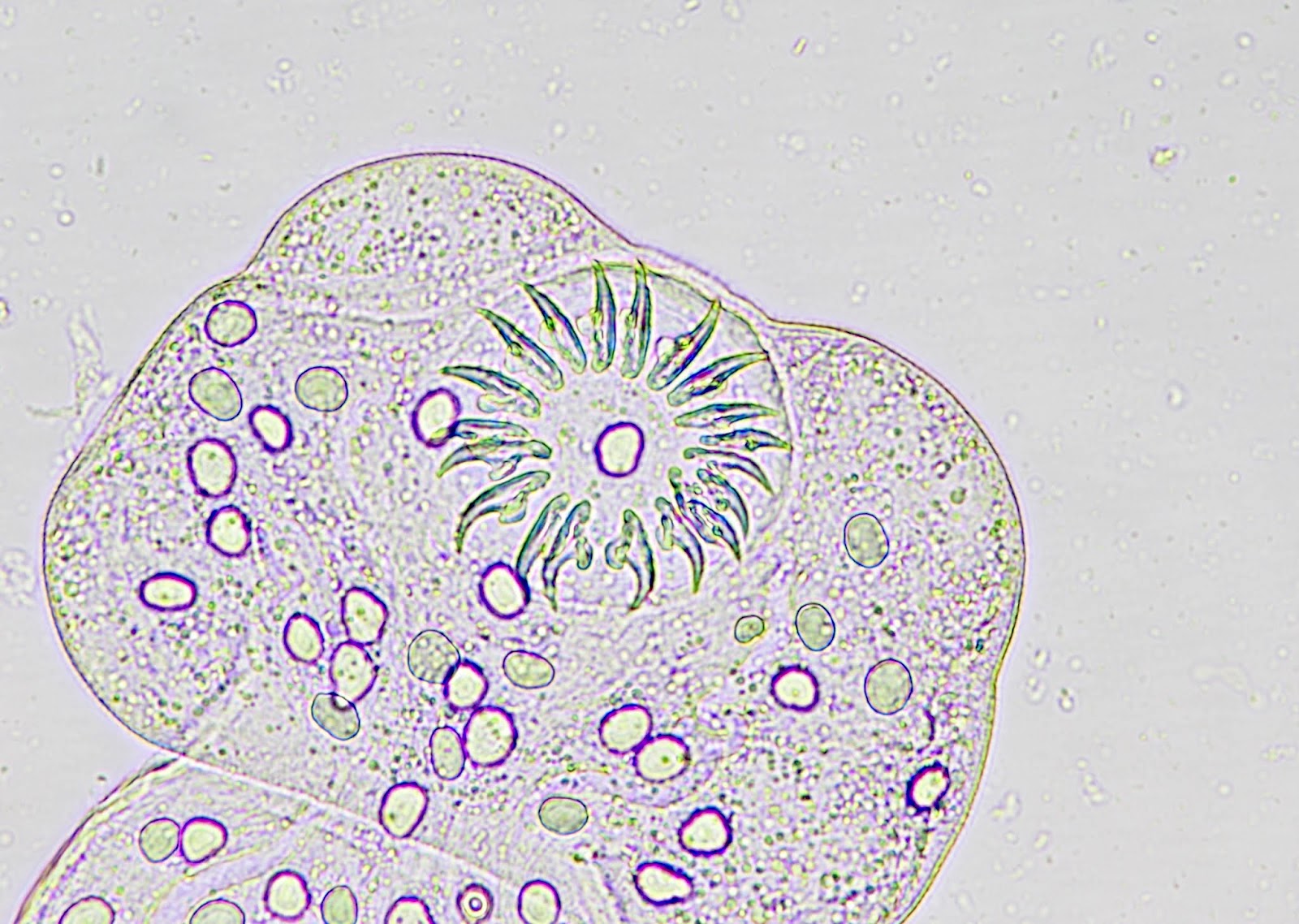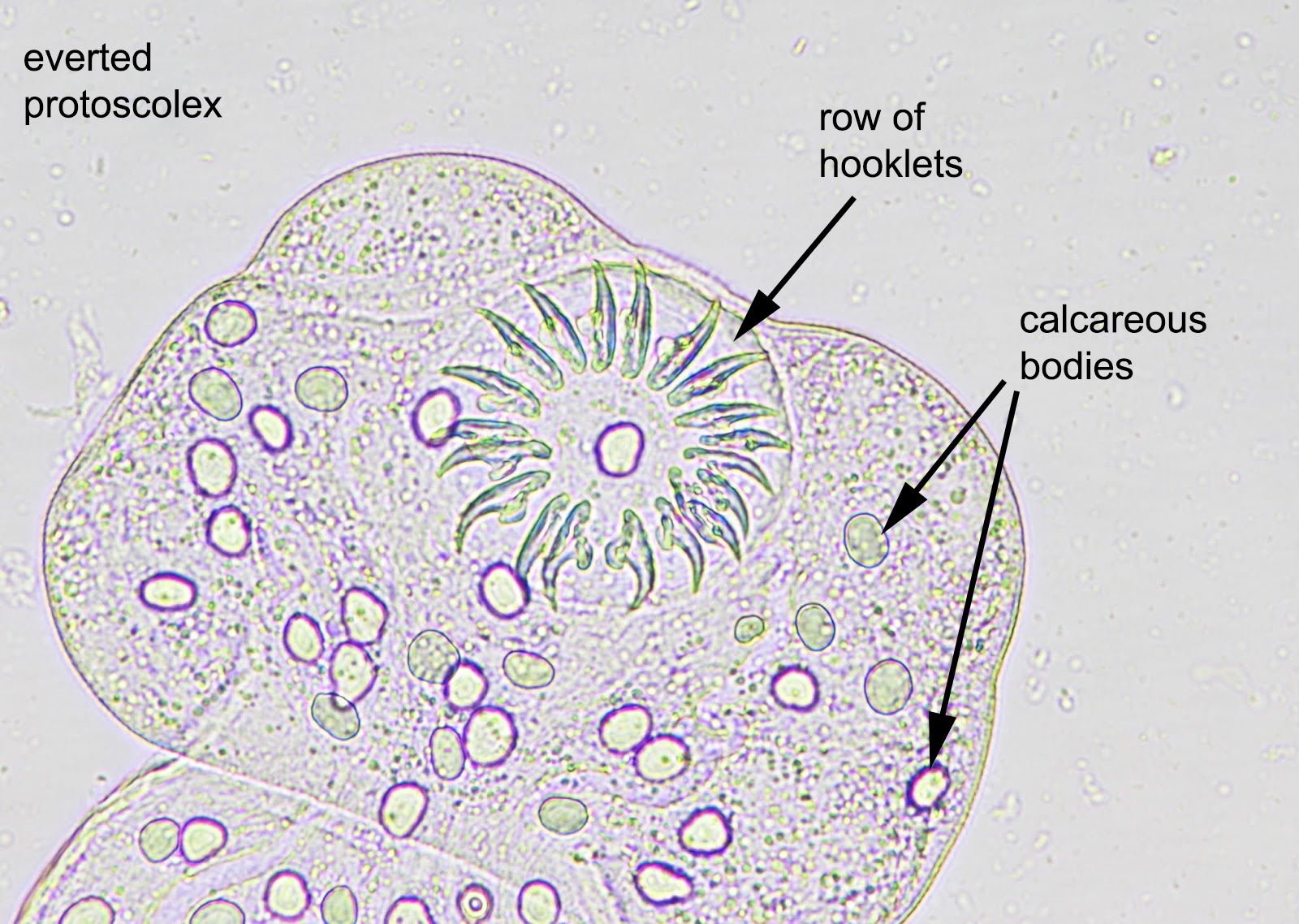Table of Contents
Definition / general | Essential features | Terminology | ICD coding | Epidemiology | Sites | Pathophysiology | Etiology | Clinical features | Diagnosis | Laboratory | Radiology description | Radiology images | Prognostic factors | Case reports | Treatment | Clinical images | Gross description | Gross images | Microscopic (histologic) description | Microscopic (histologic) images | Virtual slides | Positive stains | Videos | Sample pathology report | Differential diagnosis | Additional references | Board review style question #1 | Board review style answer #1 | Board review style question #2 | Board review style answer #2Cite this page: Aghighi M, Fazlollahi L. Echinococcal cyst. PathologyOutlines.com website. https://www.pathologyoutlines.com/topic/liverechinococcal.html. Accessed April 19th, 2024.
Definition / general
- Cestode (tapeworm) infection widespread across the world
- Common cause of hepatic cysts; caused by the larval form of Echinococcus tapeworms: Echinococcus granulosus (most common, causes cystic disease), Echinococcus multilocularis (less common, causes alveolar disease), Echinococcus vogeli (polycystic disease) and Echinococcus oligarthus (extremely rare, unicystic form)
Essential features
- Cestode (tapeworm) infection widespread across the world
- Echinococcus granulosus is the most common (classic hydatid cyst)
- E. granulosus cysts consist of inner, middle and outer layers
- Inner layer is a germinal layer with brood capsules and protoscolices (adult tapeworm heads)
- Middle layer consists of hyalinized, laminated and acellular material
- Outer layer consists of granulation tissue and fibrosis
Terminology
- Hydatid disease
ICD coding
- ICD-10: B67. 90 - echinococcosis, unspecified
Epidemiology
- Common cause of hepatic cysts worldwide, particularly in sheep and cattle in farming areas in Middle East, Greece, Australia, North Africa and parts of South America
- In U.S., usually in immigrants from above areas
- Reference: World J Gastroenterol 2012;18:1425
Sites
- 60 - 70% in liver; also brain, lung, other sites
- Frequently communicates with biliary tract (Iran J Med Sci 2013;38:2)
- Rare in breast (0.27% of cases) but should be considered in the differential diagnosis of a breast mass in endemic regions (J Gynecol Obstet Biol Reprod (Paris) 1986;15:187)
Pathophysiology
- Mucosal attachment of tapeworm to small intestine in definitive hosts, such as dogs (CDC: Echinococcosis [Accessed 4 March 2022])
- Ingestion of eggs in contaminated feces can infect humans
- Larval oncospheres are released from eggs and are transported to liver by portal vein
- Oncospheres grow into cysts enlarging at slow pace of about 10 - 15 mm per year
- Cysts are composed of protoscolices and daughter cysts (J Clin Transl Hepatol 2016;4:39)
Etiology
- Liver as primary site of infection:
- E. granulosus
- E. multilocularis
Clinical features
- Often asymptomatic for years due to slow growth but hepatic and pulmonary symptoms are most common
- Symptoms can be secondary to cyst rupture or compression of other structures
- Bacterial infection, bile duct compression, cholangitis, rupture into peritoneal or pleural cavities
- Portal hypertension secondary to portal vein compression
- Breast masses (Folia Med (Plovdiv) 2020;62:23)
- Rupture of cysts in the lung may cause intense cough or vomiting of cystic materials (Curr Opin Pulm Med 2010;16:257)
- Clinically may resemble carcinoma
- Parasitic flatworm (tapeworm) of class Cestoda (i.e., a cestode) (Pritt: Creepy Dreadful Wonderful Parasites Blog - Answer to Case 514 [Accessed 4 March 2022])
- Member of family Taeniidae due to presence of an armed rostellum (i.e., 2 rows of hooklets) (Pritt: Creepy Dreadful Wonderful Parasites Blog - Answer to Case 514 [Accessed 4 March 2022])
- Echinococcus granulosus is a complex of closely related organisms (Pritt: Creepy Dreadful Wonderful Parasites Blog - Answer to Case 514 [Accessed 4 March 2022])
- E. granulosus sensu stricto is most common species causing human disease worldwide
- E. canadensis and E. ortleppi also cause human disease
- Species are differentiated via molecular means
- Alveolar echinococcosis is caused by infection with larval stage of E. multilocularis, a 1 - 4 millimeter long tapeworm found in foxes, coyotes, dogs (definitive hosts)
- E. multilocularis human infection is less common but has more aggressive and invasive growth that resembles a tumor and is not contained within a large parent cyst (Pritt: Creepy Dreadful Wonderful Parasites Blog - Answer to Case 514 [Accessed 4 March 2022])
- E. oligarthra and E. vogeli are rare causes of human echinococcosis in South and Central America (Pritt: Creepy Dreadful Wonderful Parasites Blog - Answer to Case 514 [Accessed 4 March 2022])
- Breast: slow growing lesion, may mimic fibroadenoma, phylloides or rarely intracystic carcinoma; may become infected and be indistinguishable radiologically from an abscess
Diagnosis
- Usually made by ultrasound or CT scan supported by positive hydatid serology
Laboratory
- Monoclonal antibodies to hydatid antigens detection by immunoelectrophoresis, enzyme linked immunosorbent assay (ELISA) and immunoblots
- Immunoblots have the highest sensitivity, followed by ELISA and immunoelectrophoresis
- Antigen assays have more specificity but lower sensitivity than antibody assays
- Unruptured cysts may not produce antibody response (J Clin Transl Hepatol 2016;4:39)
Radiology description
- Ultrasound / CT scan reveal cysts with septations
- Breast: on mammography, lesions may be well circumscribed, oval or spherical densities with smooth lobulated margins; peripheral calcification may be present
- Breast: on ultrasound, may see double wall sign (cyst wall as 2 echogenic layers), snowstorm sign (due to movement of scolices within the cyst), waterlily sign (floating membranes due to detached endocyst / daughter cyst), scroll sign (due to folding of the detached endocyst) (J Clin Ultrasound 2014;42:502, Singapore Med J 2010;51:e72)
Radiology images
Prognostic factors
- Although mortality is uncommon, fatalities have been reported in rare cases of anaphylactic shock or cardiac tamponade (Acta Cardiol 2005;60:39)
- Ruptured cystic disease may require lifelong antiparasitic therapy to prevent recurrence
- Most common complications are mechanical and superinfection (Am J Trop Med Hyg 2019;101:628)
Case reports
- 8 year old girl with cystic echinococcosis involving left ventricle (Medicine (Baltimore) 2019;98:e15267)
- 25 year old man with abdominal pain, syncope and hypotension (N Engl J Med 2015;372:265)
- 31 year old year old woman with painless breast lump for 1 year (Int J Surg Case Rep 2015;7C:115)
- 32 year old man with an Echinococcus cyst in liver and pancreas (BMC Infect Dis 2019;19:661)
- 62 year old woman with a huge Echinococcus cyst in liver resembling malignancy (J Med Case Rep 2017;11:113)
- Echinococcus found in a single liver cyst (Pritt: Creepy Dreadful Wonderful Parasites Blog - Case of the Week 514 [Accessed 4 March 2022])
- Objects seen in liver cyst aspirate (Pritt: Creepy Dreadful Wonderful Parasites Blog - Case of the Week 537 [Accessed 4 March 2022])
Treatment
- Surgical resection
- Cyst rupture during surgery may cause urticaria, anaphylaxis or recurrence of infection
- Puncture, aspiration, infusion of protoscolicidal agent, reaspiration
- Preferred technique due to lower risk of anaphylaxis or recurrence (BMC Surg 2019;19:95)
Gross description
- Echinococcus granulosus: typical cyst is spherical, up to 30 cm or more in diameter, has a fibrous rim and frequently contains several daughter cysts
- Echinococcus multilocularis: multilocular, necrotic, cystic cavities containing thick pasty material; fibrous rim is absent
- Reference: Zhonghua Bing Li Xue Za Zhi 2021;50:650
Gross images
Microscopic (histologic) description
- E. granulosus
- Cyst wall has 3 structural components:
- Outer acellular laminated membrane (1 mm thick)
- Germinal membrane (a transparent nucleated lining)
- Protoscolices, attached to the membrane and budding from it
- Protoscolices are ovoid and contain hooklets (birefringent under polarized light) and a sucker
- Outer fibrotic layer with granulation tissue with increased eosinophils also exists
- Cyst wall has 3 structural components:
- E. multilocularis
- Irregular cysts with laminated membrane without germinal membrane or protoscolices
- Invasion of liver parenchyma can create inflammatory / granulomatous reaction or extensive peripheral necrosis and fibrosis
- Reference: Zhonghua Bing Li Xue Za Zhi 2021;50:650
Microscopic (histologic) images
Positive stains
- Hooklets are acid fast positive on Ziehl-Neelsen stain; also stain with GMS (J Cytol Histol 2016;7:1000422)
Videos
Bird's eye view of Echinococcus
Sample pathology report
- Liver, excision:
- Echinococcal cyst
- Comment: There are degenerated echinococcal cysts that contain abundant debris with protoscolices fragments.
Differential diagnosis
- Other tapeworm infections: cysticercosis (Taenia solium)
- Fibropolycystic liver disease:
- Lacks 3 layered cyst, protoscolices
- Numerous cystic lesions similar to solitary cysts, covered by cuboidal to flat biliary epithelium
- Amoebic or pyogenic abscess:
- Lacks 3 layered cyst, protoscolices
- Nuclear fragments with inflammatory cells
- Organisms with foamy cytoplasm and eccentric round nucleus
- Ingested red blood cells pathognomonic of Entamoeba histolytica
- Trophozoites look like macrophages
Additional references
Board review style question #1
A 45 year old man presented with weakness, weight loss and abdominal pain for a month. An ultrasound showed a cystic lesion in liver. The cystic lesion was resected and revealed cysts consisting of inner, middle and outer layers. Which of the following is the best diagnosis?
- Cystic hepatocellular carcinoma
- Echinococcus granulosus cysts
- Hemorrhagic cysts
- Polycystic liver disease
Board review style answer #1
Board review style question #2
A 65 year old woman presented with fever, jaundice, weight loss and abdominal discomfort. She lives in the countryside with her 2 dogs. CT scan of liver revealed large cystic mass, suspected to represent an echinococcal cyst. Which of the following is the most likely microscopic feature?
- Cystic lesion with inner, middle and outer layers and protoscolices
- Ingested red blood cells
- Numerous cystic lesions similar to solitary cysts, covered by cuboidal epithelium
- Organisms with foamy cytoplasm and eccentric round nucleus
Board review style answer #2
A. Cystic lesion with inner, middle and outer layers and protoscolices
Comment Here
Reference: Echinococcal cyst
Comment Here
Reference: Echinococcal cyst








